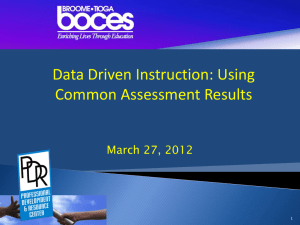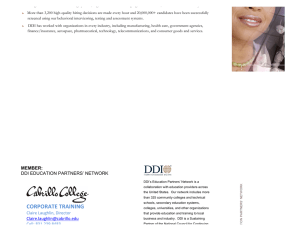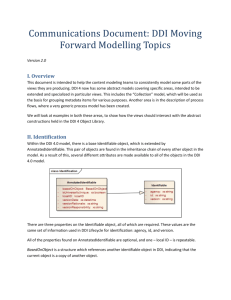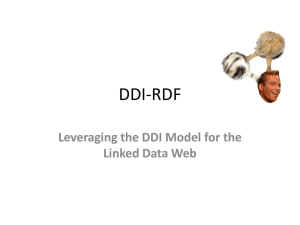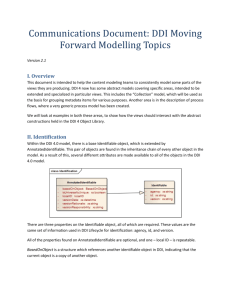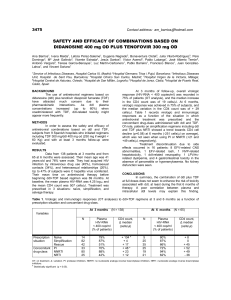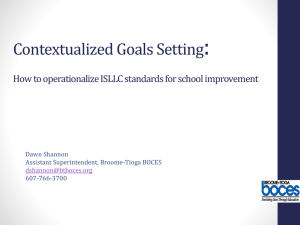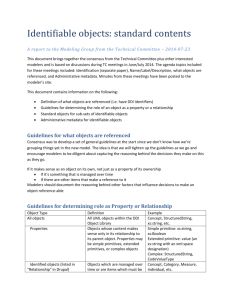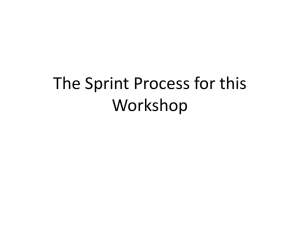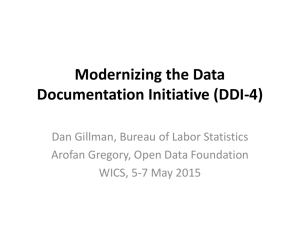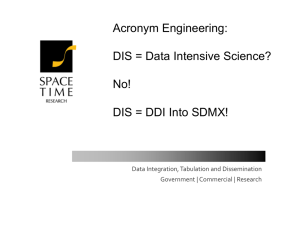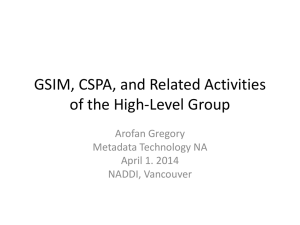SERPent: Secure Epidemiology Research Platform
advertisement
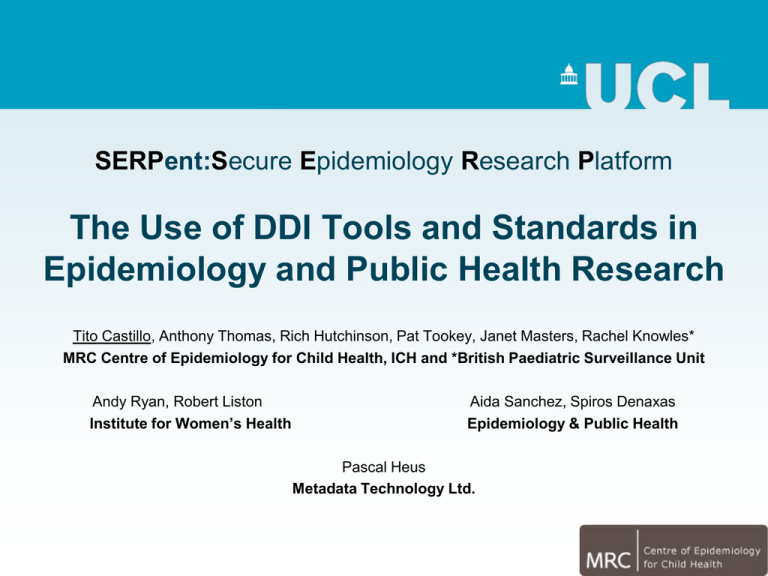
SERPent:Secure Epidemiology Research Platform The Use of DDI Tools and Standards in Epidemiology and Public Health Research Tito Castillo, Anthony Thomas, Rich Hutchinson, Pat Tookey, Janet Masters, Rachel Knowles* MRC Centre of Epidemiology for Child Health, ICH and *British Paediatric Surveillance Unit Andy Ryan, Robert Liston Institute for Women’s Health Aida Sanchez, Spiros Denaxas Epidemiology & Public Health Pascal Heus Metadata Technology Ltd. Context • MRC Centre of Epidemiology for Child Health, ICH – provides a secure computing service (epiLab) – 65 members of staff – Wide range of projects involving analysis of • • • • • 1958, 1970, 2000 UK Birth Cohorts Disease Surveillance Public health policy Record linkage Genetic epidemiology • UCL – Platform Technologies supports research infrastructure across the School of Life and Medical Sciences. – Computational Life and Medical Sciences (CLMS) encourage and support collaboration, communication and co-operation across basic and clinical sciences. – Data Managers Group network across the Biomedical faculty to promotes and share best practice in data management and curation. Peer discussion forum. Primary motivation • Creation of a secure environment designed for epidemiological research – – – – Information asset register Standardise data management procedures Support effective record linkage Transparent information governance for data access and sharing procedures – Develop common archival process Relevant Information Standards & Initiatives • Health Level 7 (HL7) – To create the best and most widely used standards in healthcare. • Clinical Data Interchange Standards Consortium (CDISC) – To develop and support global, platform-independent data standards that enable information system interoperability to improve medical research and related areas of healthcare. • Public Population Project in Genomics (P3G) – Encourage collaboration between researchers and biobankers – Promote harmonization of information – Optimize the design, set-up and research activities of populationbased biobanks – Facilitate the transfer of knowledge and provide training to those working in the field Scenario – Public Health research Multiple Secure Research ‘Enclaves’ • Distributed databases • Heterogeneous technologies • Independent information governance requirements Common requirements • Highly sensitive data • Study design & documentation • Record linkage • Multiple controlled vocabularies • Questionnaire management • Data exchange & sharing • Research transparency Project Plan • JISC Virtual Research Environment – 9 months (Jan - Sep 2010) – 6 representative use cases • Training in DDI 2.1& 3 • Annotate existing surveys in DDI 2.1 – IHSN Microdata Management Toolkit – Bespoke software utilities • Generate Catalogue – NADA web catalogue • Retrospective – Lessons learned • Collaboration – MRC Data Support Service – UK Data Archive – UK Digital Curation Centre Use cases Title Initiated Details Whitehall II Study 1985 10, 308 non-industrial civil servants (age 35-55 years) • Medical examinations + questionnaires National Study of HIV in Pregnancy in Childhood (NSHPC) 1990 Prospective surveillance of 11,500 HIV positive pregnancies in the UK UK Collaborative Trial of Ovarian Cancer Screening (UKCTOCS) 2000 202,00 women recruited and followed up to assess ovarian cancer screening services UK Collaborative Study of Congenital Heart Defects (UKCSCHD) 2004 4000 births in UK between 1992-96 with serious congenital heart defects. • Questionnaire-based survey of health, development, social activity, school and exercise. Optimising Management of Angina (OMA) 2009 Examination of quality of care given to patients with angina • Patients >40 years of age with recent onset stable angina • Face-to-face assessments Cardiovascular disease research Linking Bespoke studies and Electronic Records (CALIBER) 2009 Linked electronic patient records to investigate cardiovascular disease • General practice database • Myocardial Ischemia National Audit Project • Hospital Episode Statistics • Mortality data from the Office of National Statistics Data manager – current practice UKCSCHD CALIBRE OMA Whitehall II UKCTOCS e-Docs Paper SQL Server MS Access Survey database Separate admin db STATA MySQL SAS MSAccess MySQL MSAccess Microdata docs Sensitive field flag Derived data Data sharing plan Citation standards Open access db Public website Microdata submission Limited exclusive access to primary researchers Controlled public access Collaborative access among scientists NSHPC Data manager intentions What aspects of DDI do you intend to use in the future? UKCSCHD CALIBRE OMA Whitehall II UKCTOCS NSHPC Data sharing probably Archival probably Questionnaire design probably Instrument registration unlikely NADA Catalogue http://epilab.ich.ucl.ac.uk/nada/index.php/catalog NADA catalogue • Positive – – – – 6 studies catalogued Standard representation Searchable portal Simple publication process • Negative – Poor support for questionnaire design • Order & branching logic – No sensitive variable flags – No information about derived data – Poor support for large controlled vocabularies (clinical terminologies) – Limited support for variable types Migration path to DDI 3 • No need to tackle the whole standard in one go • Go via DDI 2.5 (release date 2011) • Questionnaire / Instrument Design – Resource Packages • Identifiable, Versionable, maintainable • Reusable • Extensible • Integrate with existing survey tools • Extend to allow for: – – – – Research funding / financial profiling Consent process Information Governance / Security Research e-Val process Existing options for integration of survey tools with DDI • Option 1: Design in DDI 3 export to Survey tool – – – – Use Colectica Designer (DDI 3 compliant editor) Commission export utility to preferred survey tool Disadvantage: Commercial product (not free) Advantage: Design based on DDI 3 semantics • Option 2: Design in survey tool then export to DDI – – – – – – – REDCap (REDCap Consortium) Rich data collection tool designed for clinical research Integration with Statistical tools Audit trail / security management wide consortium of users (over 150 partner institutions) Disadvantage: Not DDI aware, simplistic metadata model Advantage: Easy to design, export to DDI v2 Specifications • Developed in Vanderbilt University • Apache / MySQL / PHP application • Not open source, requires consortium membership • Metadata-driven design • Rapidly evolving platform Longitudinal design with REDCap Reuse forms for multiple data entry • Define multiple arms & events for each arm • Associate events to specific data entry forms • Traffic-light progress dashboard Export questionnaire design (REDCap to DDI) REDCap Variable Acknowledgements UCL Prof Ian Jacobs External Chris Rusbridge Director, Digital Curation Centre Dean Health Sciences Research UCL and NHS Partners Neil Geddes Prof Carol Dezateux e-Science Director, Science & Technology Facilities Council Director, MRC Centre of Epidemiology for Child Health, ICH Melanie Wright Prof Sir Michael Marmot Head of Epidemiology and Public Health Department Director, ESRC Secure Data Service, UK Data Archive Andrew Westlake Retired Statistician Department of Epidemiology & Public Health
